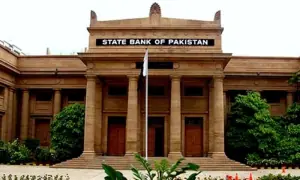Moody’s expects 3-4% growth this year in Pakistan
Moody’s Investors Services (Moody’s) expects Pakistan’s economic growth of 3-4 percent for 2022 and 4-5 percent for 2023, saying that the reform agenda and the China-Pakistan Economic Corridor (CPEC) to help boosting economic growth.
Moody’s maintained a stable outlook for the banking sector in Pakistan (B3 stable), saying this balances good economic momentum and growing financial inclusion that are boosting lending opportunities, against political uncertainty in Pakistan and higher inflationary pressures due to the Russia-Ukraine conflict.
Moody’s in its latest report stated that Pakistani banks successfully navigated the pandemic and it expects nonperforming loans (NPLs) to remain high but broadly stable at around nine percent of gross loans. Investment gains are likely to be lower.
However: “We expect dividend payouts to rise this year, but earnings should be sufficient to keep capital at current, rather modest, levels. Pakistani banks will remain deposit funded and liquid. These are credit strengths, but their high exposure to Pakistan government securities means their credit profiles are anchored to the low-rated sovereign,” it added.
Moody’s further stated that its stable outlook is underpinned by an expanding economy and banks’ resilient financial metrics operating conditions will be supportive for banks, despite new pressures. The Russia-Ukraine military conflict will pressure Pakistan’s current account deficit via higher oil prices, while rising inflation will weaken private-sector spending. Sharp increases in interest rates will also weigh on private-sector investment.
Initiatives to deepen financial inclusion including the introduction of an instant digital payment system and simplified account opening procedures offer new lending opportunities for banks. Government support for specific sectors, such as a subsidy scheme for housing finance, and subsidised interest rates and partial credit guarantees for small businesses and agriculture, will also boost credit demand. Accordingly, we expect credit growth to exceed 12 percent in 2022, it added.
Moody’s stated that asset risk is mainly linked to banks’ high exposure to government securities. Pakistani banks’ exposure to government securities account for 45 percent of their total assets and around seven times their equity, one of the highest levels among our rated banks, globally. This exposure links their credit profiles to the sovereign’s.
It further stated that after a moderate rise in problem loans during the pandemic, we now expect these to stay around nine percent of gross loans for the rated banks. Loans to sugar, textiles and leather, and electronics sectors will be the most vulnerable. The phased introduction of the new IFRS 9 accounting standard, which contains stricter rules on loan-loss provisioning will likely increase provisioning needs. However, these already stand at around nine percent of gross loans, almost fully covering problem loans.
Capital buffers will be stable, but modest. According to data from the State Bank of Pakistan, the banking sector’s capital-to-assets ratio stood at 6.3 percent as of December 2021. The sector’s reported Tier 1 capital stood at 13.5 percent of risk-weighted assets. Once we thought risk-weight government securities at 100 percent in line with the government’s B3 credit rating; however, tangible common equity (TCE) to adjusted risk-weighted assets drops to a modest 7.4 percent for the rated banks. Moody’s own stress scenario1 projects a severe impact, although capital buffers remain broadly stable under our baseline scenario. More specifically, for 2022 we expect banks to increase their dividend pay-out ratios to pre-pandemic levels of around 50 percent to 60 percent, but retained earnings will be sufficient to fund balance sheet growth and keep reported capital ratios steady. Profitability will rise moderately.
“We expect Pakistani banks to deliver an average return on assets of around 1 percent to 1.1 percent in 2022. Earnings will be supported by balance sheet growth of over 15 percent and gradually widening interest margins due to higher interest rates. Rates have risen by 275 basis points during 2021 and further increases are envisaged in 2022,” said Moody’s adding that it expects provisioning costs to hover around their through-the-cycle levels of 60-80 bps of gross loans, while operating costs will increase broadly in line with inflation. Foreign-exchange income and securities gains/ losses will remain a volatile part of revenues and vary considerably among banks.
Funding and liquidity conditions will remain stable. Deepening financial inclusion and funds from non-resident Pakistanis2 are broadening the inflows of domestic deposits that fund the banks’ lending activities. Customer deposits accounted for 67 percent of total assets as of end December 2021. Liquidity is also solid, with around 12 percent of assets held as cash and inter-bank placements and an additional 45 percent invested in government securities (a large proportion of which can be repo’ed with the central bank in case of need). The SBP has also introduced additional Shariah-compliant liquidity facilities for Islamic banks. Some pressure points remain but these will be manageable. The introduction of a Treasury Single Account will lead to modest deposit outflows and Pakistan’s inclusion on the Financial Action Task Force (FATF)’s grey list of countries with deficient anti-money laundering regimes is being addressed with 26 out of the 27 actions required already completed.
Pakistani banks hold a high share of market funding (22 percent of total assets as of end December 2021) but mainly in the form of inter-bank and SBP) repo (repurchase agreement facilities, used for “carry trade” transactions. Related liquidity risks are; therefore, contained, although such activities expose banks to additional credit and interest-rate risks. The probability of government support for failing banks is high. The government remains willing to support the country’s banks in a crisis, given banks’ role as the main source of financing for the government and the need to avoid disruptions to the payments system. Its ability to do so; however, is limited by fiscal challenges reflected in its B3 credit rating. In recent years, authorities have enhanced their bank resolution tools to include the write-down of shareholders’ capital and subordinated debt instruments; requesting the injection of new capital; and facilitating a merger or acquisition by another bank. The amount of insured deposits has also doubled to Rs500,000 per depositor, covering approximately 98 percent of depositors and 20 percent of total deposits.
The story was originally published in Business Recorder on April 12, 2022.
For the latest news, follow us on Twitter @Aaj_Urdu. We are also on Facebook, Instagram and YouTube.





















Comments are closed on this story.